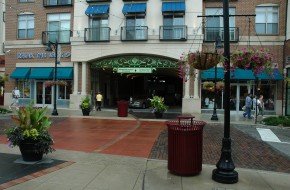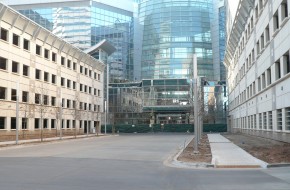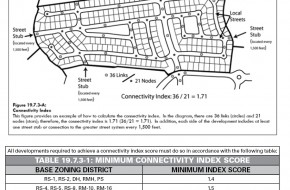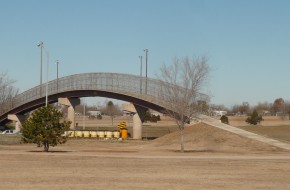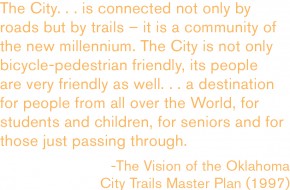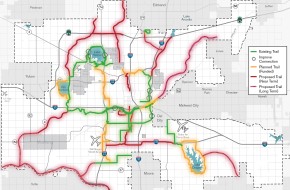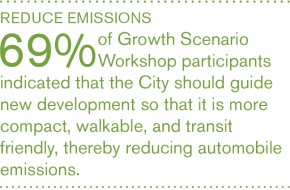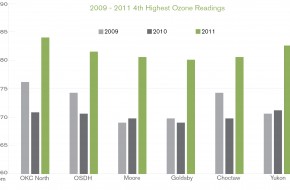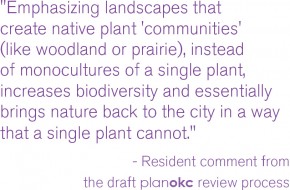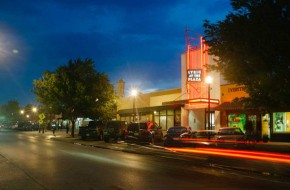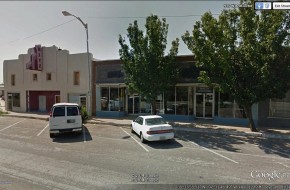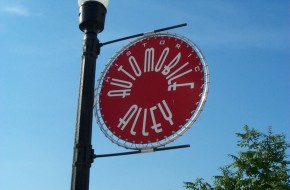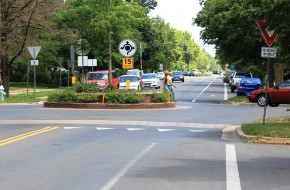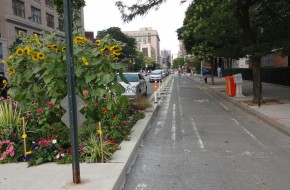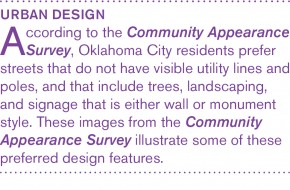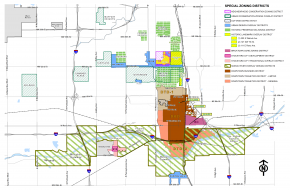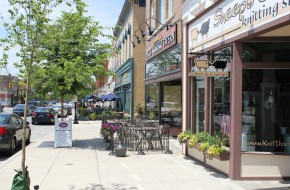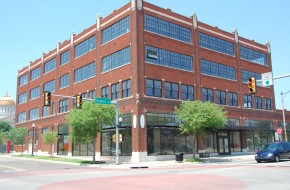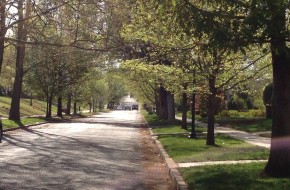The initiatives below relate to streets. Click on any initiative to view a full explanation and related policies.
We will create a high-density downtown by providing efficient parking, excellent automobile, bicycle, and pedestrian circulation, and development policies that promote density.
We know that private automobile transportation and the space that cars require work against high-density development. We also know that downtown must accommodate private cars to succeed, but should provide better alternatives for people moving between features within the district. High density development itself brings more things closer together, making walking, biking (including bike share systems), and transit circulators like modern streetcars the most efficient and pleasant ways to go.
We can institute this "virtuous cycle" by:
- Redeveloping surface parking lots with new development, providing new parking in parking structures, and integrating structured parking vertically into new projects.
- Developing enhanced transit to downtown and "density-friendly" circulation to points within downtown, including pedestrian and bicycle facilities (including bike share) and the modern streetcar circulator included in the MAPS 3 capital program.
- Preserving and restoring to the degree possible the urban grid of blocks in Downtown Oklahoma City, re-establishing pedestrian linkages lost during the superblock era of Downtown redevelopment.
- Revising development ordinances to limit surface parking, encourage mixed uses on at least the street level of parking garages, and increase overall development yields.
Click to expand policy information.
Maintain existing alleys or construct new alleys where feasible to provide trash collection service and parking behind primary buildings and minimize curb cuts along the primary street frontage.
Prohibit new single-use, on-street commercial surface parking lots from locating Downtown and create incentives for the redevelopment of existing commercial surface parking lots with appropriately-scaled infill development.
Provide incentives for developers to build parking garages in high density areas. Include design requirements for projects receiving incentives.
Evaluate existing regulations for effectiveness in promoting density and mixed-use development and in addressing surface parking. Develop a new urban design code for downtown and other key districts to promote healthy mixes of land uses that are compatible and complementary.
We will ensure that street improvements and expansions to the network serve the development vision of planokc. The Land Use Plan, the foundation of planokc, is based on efficient use of land resources, and incremental, market-based extensions of urban development. Road construction projects in undeveloped areas can have the opposite effect by encouraging decentralized development. Both city and regional road plans should reinforce the vision of efficiency by focusing on enhancing the existing network, addressing areas of congestion and poor operation, increasing network connectivity and route choice, and using new street extensions to guide development in desirable directions.
We will implement the street typology concept. The street typologies combine the function and context of streets to produce design standards. Our subdivision ordinances and design practices should be amended to be consistent with these standards. Different land uses and intensities of development also require streets with the ability to handle the traffic they generate. Therefore, new development should be located on streets of appropriate type and capacity, or include measures necessary to supply the required capacity.
Click to expand policy information.
Coordinate the design, development, expansion, and/or investment in transportation projects with the Land Use Typology map.
Require traffic impact analyses with all comprehensive plan amendments requests to change to a higher intensity LUTA.
Require the construction of new streets, streetscapes, and street widening projects to implement the design components of the assigned street typologies established in this plan.
Share parking among contiguous developments.
Revise Subdivision Regulations and development standards to reflect the street typology standards.
Identify and prioritize freight infrastructure projects that are needed to maintain mobility and enhance the city’s (and region’s) economic competitiveness.
Undertake targeted parking studies to determine existing parking capacity and develop appropriate parking standards based on land use, location, and demand.
Require sidewalks on both sides of all streets in urban LUTAs and in the Rural Residential LUTA for subdivisions with densities greater than 1 unit per acre.
Maintain historical lot and block sizes where possible and appropriate.
Assess the need for additional funds for citywide road maintenance beyond past average annual expenditures. If additional funds are needed for street maintenance, explore the feasibility of:
- Implementing a transportation utility fee; or
- Increasing the proportion of G.O. Bond money spent on street maintenance over past levels.
We will provide good street connections within and between neighborhoods to provide a choice of routes and separate local traffic from major arterials. Good street connectivity has many benefits. By providing alternative routes for short distance trips, it indirectly increases the capacity of arterial streets. It also provides better quiet street opportunities for pedestrians and bicyclists, and improves the efficiency of delivering emergency access and city services.
Click to expand policy information.
Maintain the traditional grid street pattern where it currently exists, reconnect it where possible, and keep alleys open and functioning. When improving older streets in neighborhoods, maintain original street widths and curb radii.
Improve the functionality and efficiency of the street network by:
- Providing direct connections from residential developments to nearby places and to each other.
- Providing street and sidewalk stubs to adjacent vacant land in anticipation of future development.
- Connecting new development to existing street and sidewalk stubs, and to existing trail, open space, and bicycle networks.
- Reducing block sizes and use of dead-end streets.
- Maintaining the existing street grid to preserve connectivity and mobility options.
Revise subdivision regulations to include connectivity standards and guidelines that require greater street connectivity, and provide allowances for pedestrian and bicycle connections when street connectivity cannot be made.
Change subdivision regulations to determine the number of entries into a residential development based on number of lots in order to improve connectivity of the roadway network and emergency response.
Maintain existing alleys or construct new alleys where feasible to provide trash collection service and parking behind primary buildings and minimize curb cuts along the primary street frontage.
Target specific areas of the city for enhanced safety and proactive enforcement. Selection of target areas will be informed by the Intelligence Led Policing program, with coordinated involvement from Police, Code Enforcement, Public Works Department, Planning, and community-based organizations.
Evaluate development proposals to assess design components that contribute to or detract from safety and analyze emergency response capacity and capability.
We will establish a systematic neighborhood street program, focused on rehabilitation, traffic calming, and safety and functional improvements. Citizens place a high priority on the condition and repair of the existing street system. The streets that affect residents most – local and connector streets – are rarely addressed by normal transportation programs. A systematic neighborhood street program will both provide regular funding for street repair and rehabilitation and completion of special street projects such as traffic calming.
Click to expand policy information.
Establish a process for existing neighborhoods to request traffic calming, including how to evaluate the request, select the appropriate type of calming treatment, and fund recommendations.
Improve parking provisions in neighborhoods that are near vibrant commercial corridors/areas by improving parking and corridor design, non-vehicular networks, transit, and signage.
Incorporate preventive health care and wellness education into public schools, recreation centers, senior centers, and technical/trade schools.
Evaluate development proposals to assess design components that contribute to or detract from safety and analyze emergency response capacity and capability.
We will incorporate all appropriate forms of transportation into major street and land use corridors. Major corridors provide access to important community destinations, including shopping centers, civic institutions, and employment centers. Multi-modal corridors do not require every form of transportation on every major street. Rather, the corridor taken broadly provides access for all modes of transportation to destinations along the way. For example, service roads, local streets, trails, or other paths parallel to arterials can accommodate local transit, pedestrians, and bicyclists comfortably. The concept of multi-modal corridors also requires that projects that change or expand the motor vehicle capacity of major streets and roads accommodate transit and active modes in the final design and during the construction process.
Click to expand policy information.
Set level of service goals and adopt standards to improve the performance of pedestrian, bicycle, and transit facilities. Emphasize pedestrian, bicycle and transit infrastructure in street widening designs.
Require the construction of new streets, streetscapes, and street widening projects to implement the design components of the assigned street typologies established in this plan.
When approving projects that improve the level of service for vehicular traffic, ensure they do not negatively impact the walkability or bikeability of the area.
Locate, design and upgrade City facilities and infrastructure in a manner that supports neighborhood revitalization and redevelopment.
We will maximize the safety and efficiency of arterials by developing and implementing new standards and strategic access management projects. New design standards and practices should reduce the number of driveway cuts on streets, encourage shared access points, develop properly designed service roads where appropriate, and align curb cuts across streets wherever possible. These changes are usually good for business because they increase the efficiency of parking, reduce crashes and conflict points, and reduce stress on customers and motorists.
Click to expand policy information.
Prioritize opportunities to restore and reconnect the street grid.
Establish access management requirements that limit driveways on arterials and collectors and increase connections between uses to improve safety and traffic efficiency.
Limit driveways on arterials and collectors and increase connections between uses to improve safety and traffic efficiency.
Share parking among contiguous developments.
Ensure proper access to and between subdivisions in order to offer a choice in routes for residents, multiple access points for emergency responders, and to reduce vehicle congestion at arterial intersections. Contiguous developments should share access whenever feasible.
Regional-, community-, and neighborhood-scale retail developments should provide an internal vehicle and pedestrian circulation system between new and existing centers and individual stores that draws on the following principles:
- Concentrate access for new retail development at shared primary entrance points. Primary entrance points should be aligned with access points immediately across intersecting roads. Limit curb cuts on primary highways and arterials.
- Provide pedestrian circulation, including sidewalks and median breaks along interior and exterior fronting roads and within parking lots.
- Encourage coordinated development of retail centers in order to facilitate internal pedestrian and vehicle circulation and optimal center performance.
Encourage unified planning for all adjoining land owned or controlled by a project’s developer to ensure proper circulation and land use relationships.
We will develop facilities that encourage people to use other means of transportation to travel to transit stops and stations. The traditional service area around a transit route is a 1/4 mile walking distance. We should maintain clear and continuous pedestrian routes within that service area to transit stops or stations. Safe, comfortable, and attractive shelters and waiting areas should be located at strategic points along routes. Providing features that encourage people to bike or drive to stops and stations can extend these service areas and increase the number of potential riders. These features can include:
- Connections from trails to transit stops.
- Bike parking, lockers, and potentially rental stations at major transit stops and hubs.
- Park and ride facilities such as lots and structures, integrated into transit-oriented developments or at appropriate commuter sites.
Click to expand policy information.
Develop design standards for bus stops and transit stations that consider location, make connections to sidewalks and bicycle routes/trails, and provide safe, comfortable, and attractive waiting areas for riders.
Locate, design and upgrade City facilities and infrastructure in a manner that supports neighborhood revitalization and redevelopment.
We will incorporate transit access into street design standards and projects on appropriate corridors. As streets that carry transit routes are improved or modified, their design should include features that specifically encourage amenities, pedestrian access, and smoother operations. These features may include enhanced pedestrian access and street crossings at transit stops; signal cycles that give pedestrians time to cross streets; space for shelters; signal controls; and reserved lanes or "JUMP" lanes for bus rapid transit. In addition, street typology standards that include transit-friendly features should be implemented.
We will implement standards that provide good transit access and user connections to major projects on transit routes. The length and nature of the path between a transit stop and the entrance to a major destination determines whether a project really has adequate transit service. For example, a stop should not require people to find their way across a large parking lot to enter the development. New design standards for large projects with transit potential should provide safe and comfortable links from the transit stop, or provide routes into the project for transit use.
Click to expand policy information.
Revise development standards to require sidewalks and transit stops along existing and planned transit routes.
Develop design standards for bus stops and transit stations that consider location, make connections to sidewalks and bicycle routes/trails, and provide safe, comfortable, and attractive waiting areas for riders.
Ensure that new publicly financed developments – those which directly use or receive public dollars – with more than 100 units or with densities greater than 10 units/acre are located where they have easy access to frequent transit service.
We will design and implement a bicycle route system based on getting people to priority destinations. The current Bicycle Transportation Plan provides a two-phased network of potential bike routes. This network is based on evaluating various streets for bicycle suitability, and provides a solid foundation for implementation. The system should now be refined by considering destinations and designing routes that assemble on-street segments and trails into an entire network that serves multiple destinations.
We will incorporate appropriate support features such as bike parking and wayfinding signage into the system. On and off-street facilities function best with relatively inexpensive support facilities like parking and information graphics. Zoning ordinances and cost-sharing programs can both require, and encourage through incentives, bike parking for appropriate land uses, like major commercial, multi-family, and mixed use development. Desirable city actions include installing bike parking in public parking structures and business districts and encouraging bike "corrals" in which one parking space is dedicated to bike parking in neighborhood business districts.
Click to expand policy information.
Identify areas that could be used to establish a greenbelt network throughout the City that connect major employment centers, commercial sites, parks, and key locations within major residential neighborhoods. Use the greenbelt as the backbone for a bicycle trails network which all other bicycle trails feed into.
Create and implement a citywide bicycle and pedestrian master plan that addresses riders of all levels.
Require the placement of secure, properly positioned bicycle parking within multi-family and commercial development, and in all public parking garages.
We will establish and execute annual goals for completion of new bicycle infrastructure. Annual installation commitments ensure that new facilities are installed in a systematic way. These goals may be established for specific destination-based routes or for miles of such new facilities as shared use lanes or bike lanes. The annual performance goals also include incorporating bicycle facilities into resurfacing or construction projects of streets on the bicycle network.
Click to expand policy information.
Prioritize construction of pedestrian and bicycle facilities that improve connectivity and eliminate gaps in the transportation network.
Increase the miles of bike lanes by:
- Including bicycle lanes in future road widening, reconstruction, and resurfacing projects; and
- Adding bicycle lanes to streets that have sufficient capacity.
We will identify major obstacles to completion of important system connections and implement projects that bridge these barriers. Most interstate crossings are arterial streets, often with interchanges, creating conditions that many cyclists find hazardous. The city has previously developed projects to address these barriers such as the SkyDance Bridge over I-40 and the Woodson Park Bridge over I-44. Other barriers persist, such as the lack of safe crossings over I-44 between May Avenue and I-235, a high intensity area with many important destinations. Options for these projects include dedicated pathway bridges or retrofit of existing interchanges and arterial crossings for better pedestrian and bicycle accommodation.
Click to expand policy information.
Prioritize construction of pedestrian and bicycle facilities that improve connectivity and eliminate gaps in the transportation network.
We will work as a community to create a supportive environment based on the principles of engineering, education, enforcement, encouragement, and evaluation. The "5 E's" which the League of American Bicyclists views as the measures of a bicycle friendly community recognize that engineering (bicycle infrastructure) alone does not create a successful bicycle culture. The other components include:
- Education, making cyclists and motorists aware of the rules and practices of safety and etiquette and their mutual rights and responsibilities as road users.
- Enforcement, helping to ensure safety by enforcing rules that pertain to all users.
- Encouragement, executing events and programs that promote bicycling and its many benefits.
- Evaluation, establishing benchmarks and measurements to gauge the effectiveness of bicycling initiatives.
Click to expand policy information.
Create and implement a citywide bicycle and pedestrian master plan that addresses riders of all levels.
Incorporate preventive health care and wellness education into public schools, recreation centers, senior centers, and technical/trade schools.
We will design or retrofit trails to provide convenient and barrier-free access to adjacent streets and major destinations. A trail that provides miles but does not connect to its surroundings may provide benefits to people seeking workouts, but it fails in its transportation mission to move people to places. In addition, poor access or visibility to and from surroundings can create public safety problems as well. We must design new trails and retrofit existing trails to provide frequent and comfortable access to wayside destinations and streets, with clear signage that helps orient users to their location.
Click to expand policy information.
Create a standards for trails based on industry standards, “Crime Prevention Through Environmental Design” principles, expected use, and surrounding land uses.
Acquire easements in new and existing developments to develop and connect trails.
Establish connections between parks, residential areas, and other points of interest by constructing additional bike routes, trails and pedestrian paths to meet the growing demands for recreation and alternative transportation routes.
Require that new development tie into the park and trail system by providing linkages to existing parks or dedicating new park land. Connect existing parks and neighborhoods to create a continuous system of open spaces, for example along stream corridors.
We will implement sidewalk requirements for both land use typology areas (LUTAs) and street typology standards in city development ordinances and standard practice. Different LUTAs will have different levels of pedestrian activity. Thus, different solutions may be applied to achieve the overall goal of providing appropriate pedestrian service. For example, a loop of local streets in an Urban-Low Intensity LUTA and a street grid in an Urban High-Intensity area will require different approaches to achieve areawide service. Different types of streets also have different sidewalk requirements based on their function and context. City design standards and implementing ordinances should reflect these differences in width, setback, connection, density, and presence of alternatives like trails or other off-street paths.
Click to expand policy information.
Establish regulations that require pedestrian connections between new commercial development and adjoining residential areas.
Prioritize street maintenance projects in the Capital Improvement Plan based on the Public Works Department’s street condition data and traffic volumes.
We will adopt land use and development practices that reduce the distance people must drive to meet their daily needs. In Oklahoma City, transportation is the principal cause of our most significant air quality problems. The policies included in the land use and transportation elements of planokc, which promote more compact development, mixed use, and improved transportation choice, will have a beneficial effect on automobile emissions. While cars will continue to be the primary means of transportation in Oklahoma City, even small changes in the number of miles driven, combined with greater fuel efficiency and technologies that reduce emissions, will substantially improve air quality.
We will coordinate initiatives and regulatory changes with local, regional, and state agencies to reduce motor vehicle emissions. In addition to reducing the number of miles that each person must drive, we need to make the vehicles that we use more efficient. We will improve overall fuel efficiency and reduce emissions by taking actions alone or in concert with other agencies that will increase use of alternative fuels in public and private car fleets, and consider new legislation and implement educational programs to reduce unnecessary emissions.most significant air quality problems. The policies included in the land use and transportation elements of planokc, which promote more compact development, mixed use, and improved transportation choice, will have a beneficial effect on automobile emissions. While cars will continue to be the primary means of transportation in Oklahoma City, even small changes in the number of miles driven, combined with greater fuel efficiency and technologies that reduce emissions, will substantially improve air quality.
We will develop incentives and adopt regulatory standards to reduce transportation emissions. In addition to reducing the number of miles driven, we must also improve vehicles fuel efficiency and emissions standards. Working in collaboration with local, regional, and state agencies, we will seek to increase use of clean fuels in public and private automobile fleets, consider new legislation, and implement educational programs.
We will preserve forests and encourage tree planting to improve air quality. Vegetation, particularly trees, plays a large role in both regulating and improving air quality, especially in urban areas. Trees absorb carbon dioxide and other gases, while replenishing the atmosphere with oxygen. They also help trap particle pollutants that can damage human lungs. We will improve our landscape ordinance to more effectively increase tree cover, reduce airborne pollutants, and reduce surface temperatures in the summer. We will also preserve existing trees and forested areas and encourage new tree plantings associated with development and streetscape projects.
A QUICK CALCULATION
Oklahoma City has about 227,000 households, according to the Census Bureau's American Community Survey. Most studies and trip generation estimates indicate that the typical household generates 10 trips daily. In Oklahoma City, this equals about 2.3 million trips. Estimates of the percentage of trips under two miles range from 25% to 40% of the total. For OKC, this ranges from 575,000 to 920,000 trips per day. If only one-quarter of these trips were made by active transportation modes (on foot or by bike), between 143,000 and 230,000 trips would be diverted from cars – the total number of trips on two of our busiest freeways. Assuming an average trip length of one mile, this means that in a course of a year, Oklahoma City residents would drive between 52 and 84 million fewer miles per year! According to the Environmental Protection Administration's report on Average Annual Emissions, a typical car emits .81 pounds (368.4 grams) of carbon dioxide per mile driven. So if one-quarter of short trips in our city were made by walking or biking, we would reduce CO2 emissions per year by between 42 and 68 million pounds annually.
BENEFITS OF TREES
Trees absorb carbon dioxide and potentially harmful gasses such as sulfur dioxide from the air and release oxygen that humans, and other species, need for survival.
According to the North Carolina State University Cooperative Extension, trees provide the following benefits related to air quality and air pollution reduction:
- One large tree can supply a day's supply of oxygen for four people.
- A healthy tree can store 13 pounds of carbon each year. For an acre of trees, that equals 2.6 tons of carbon storage.
- Each gallon of gasoline burned produces almost 20 pounds of carbon dioxide. For every 10,000 miles driven, it takes 7 trees to remove the amount of carbon dioxide produced if the vehicle gets 40 miles per gallon (mpg); it will take 10 trees at 30 mpg; 15 trees at 20 mpg; 20 trees at 15 mpg; and 25 trees at 12 mpg.
Click to expand policy information.
Improve the functionality and efficiency of the street network by:
- Providing direct connections from residential developments to nearby places and to each other.
- Providing street and sidewalk stubs to adjacent vacant land in anticipation of future development.
- Connecting new development to existing street and sidewalk stubs, and to existing trail, open space, and bicycle networks.
- Reducing block sizes and use of dead-end streets.
- Maintaining the existing street grid to preserve connectivity and mobility options.
Prioritize opportunities to restore and reconnect the street grid.
Prioritize construction of pedestrian and bicycle facilities that improve connectivity and eliminate gaps in the transportation network.
Identify areas that could be used to establish a greenbelt network throughout the City that connect major employment centers, commercial sites, parks, and key locations within major residential neighborhoods. Use the greenbelt as the backbone for a bicycle trails network which all other bicycle trails feed into.
Market the trails system as a transportation and recreation system to residents and visitors.
Change subdivision regulations to determine the number of entries into a residential development based on number of lots in order to improve connectivity of the roadway network and emergency response.
Support the creation of a regional transit authority and pursue the establishment of a dedicated funding source, such as sales tax or property tax to achieve long term transit service goals.
Increase frequency and time of transit operations to ensure adequate, convenient and safe service for visitors, employees, and residents.
Implement policies and strategies recommended in the 2013 COTPA Transit Service Analysis.
Develop an urban rail and/or bus rapid transit system to connect downtown with strategic corridors and nodes.
Work with the Association of Central Oklahoma Governments to implement the Early Action Compact to mitigate air quality issues.
Support and incentivize the adaptive use of existing buildings, infill development, and brownfield development.
Preserve natural habitat, maintain wildlife food sources, and reduce the risk of propagating invasive plant species by utilizing vegetation native to Oklahoma, preferably central Oklahoma, for all mitigation and habitat restoration efforts associated with new development and redevelopment projects, public and private, to the greatest extent possible.
Establish an Urban Forestry Program and City Urban Forester position to achieve the following:
- Measure and monitor tree canopy coverage and habitat on a regular basis so that any policies, programs, and regulations may be adjusted accordingly as situations change. Establish a process to maintain current data.
- Develop and maintain regulations, policies, processes, and programs that focus on protection and preservation of native trees.
- Provide assistance with proper tree selection, location, and maintenance to prevent power outages, reduce property damage, and coordinate emergency response during natural disaster events (excessive snow and ice, tornadoes, etc.), address the urban heat island effect, and reduce energy costs, etc.
- Establish programs such as tree give-aways, neighborhood planting programs, and education workshops.
- Provide resources to the public about tree selection, management, and care.
- Seek grant funding for community tree planting to improve City parks, publicly maintained rights-of-way and other areas of the city.
- Inventory the City’s street trees and develop a tree replacement program.
- Partner with volunteer and nonprofit organizations to recruit volunteers for tree planting and maintenance and to coordinate community-wide tree planting efforts.
Develop and adopt a tree preservation ordinance that achieves the following:
- Defines methods of preservation;
- Defines situations where preservation of trees is mandatory versus optional;
- Establishes incentives for tree preservation;
- Establishes mitigation options if preservation cannot be accomplished; and
- Establishes penalties for unauthorized tree removal.
Pursue methods to reduce the impact of the urban heat island effect on Oklahoma City by:
- Establishing a minimum canopy coverage requirement over paved surfaces such as parking lots.
- Instating a “continuous canopy” requirement for new streets and street reconstruction projects.
- Promoting the use of building and roofing materials that reduce heat island effects.
Coordinate with local, regional, and State agencies to pursue initiatives and regulations that help reduce automobile emissions, such as:
- Transitioning commercial and City fleets to alternative-fueled and hybrid vehicles;
- Determining the feasibility of an idling restriction ordinance for all vehicles.
Promote improved air quality and reduced ground-level ozone levels by developing a public education program that will inform residents about the air quality benefits of:
- Proper automobile maintenance
- Proper maintenance and use of gas-powered lawn and garden equipment
- Limiting car idling times
- Alternative fuels
- Alternative / active transportation modes (public transit, walking, biking, car-sharing, etc.)
- Reducing vehicle-miles traveled (VMT)
- Employer sponsored emission reduction programs (carpooling, work from home, telecommuting, etc.)
- Native landscaping (requiring less maintenance)
- Energy efficient housing / buildings
Study of the public health and environmental impacts of degraded air quality on sensitive populations living near highways.
Establish strategies, procedures and policies for City construction projects to achieve higher energy efficiency, including:
- Implementing an energy management plan for City facilities.
- Monitoring energy consumption of City facilities, tracking conservation progress, and communicating results to City administrators, employees, elected officials and the public.
- Assessing water use in City facilities to identify opportunities for conservation and implement appropriate measures.
Develop an enforcement mechanism for the City’s Building Energy Code. Develop a healthy building code to support construction of durable, health-promoting and energy efficient buildings that incorporate proven green development practices, locally-sourced and environmentally responsible materials, water conservation fixtures, innovative design and construction techniques, and low waste construction practices. Incentivize their use with shorter approval procedures, priority permits and inspections, and reduced fees.
Partner with agencies, non-profits, and private entities to:
- Implement a sustainable development online forum – an educational and networking resource that will inform the public about local opportunities and the benefits of sustainable development while increasing builder and developer participation.
- Educate citizens on energy and water conservation opportunities both at work and at home.
- Encourage appropriate re-use and reclamation of water in new development and redevelopment to reduce the reliance on potable water use.
- Provide detailed cost-benefit information about green building practices to encourage increased use of such practices in Oklahoma City.
- Reduce reliance on electricity produced by fossil fuel by encouraging the use of renewable energy sources in new development and redevelopment.
- Explore mechanisms (incentives, regulations, programs) to divert demolition debris from landfills and redirect to facilities that can reuse these materials.
- Establish a promotion/award program to showcase innovative development that utilizes low-impact development practices and energy-efficient building techniques / equipment, conserves riparian buffers, and extends greenway networks with hiking/biking trails.
Establish strategies, procedures and policies that prevent degradation or loss of critical habitat and sensitive areas, such as Cross Timbers, upland forests, wetlands, wildlife corridors, groundwater recharge zones, and riparian areas. Protection methods should ensure that placement of lots, alignment of roads, and installation of structures and infrastructure minimize disturbance of the environmentally sensitive areas using tools such as:
- Directing development to appropriate locations;
- Greenbelt preservation;
- Assurance of no development in protected open space;
- Clustering / conservation subdivisions;
- Pervious surface treatments;
- Density transfers; and/or
- Conservation easements.
Ensure that strategies, procedures, and policies incorporate principles of connectivity, minimal fragmentation, representativeness, and heterogeneity.
Encourage redevelopment and infill development on vacant, underutilized, and brownfield sites in urbanized areas.
Encourage the integration of different land uses in urban areas through the following means:
- Promote the use of performance standards in place of existing zoning methods (which address incompatibility by separating uses). Performance-based regulations should focus on achieving compatibility between uses by addressing the following:
- Noise, odors and air quality
- Traffic and parking (allow flexible, but sufficient parking)
- Site layout and building design
- Waste
- Safety
- Lighting (glare control, placement, and shielding)
- Delivery hours
- Enhance transit service (bus and rail).
- Prevent large areas of concentration of any particular land use such as multi-family or commercial.
Establish development regulations that help improve air quality, including:
- Specifying construction controls that reduce airborne dust;
- Increasing landscaping and tree planting to absorb carbon dioxide and air pollutants; and
- Encouraging development patterns and densities that support alternative modes of transportation in the urban LUTAs.
We will institute neighborhood design guidelines and practices that build community in lower-density settings. We recognize that different people have different preferences. Many people seek new houses but still want the diversity and neighborliness of the best of established neighborhoods. Others seek the bigger lots and greater personal space offered by low-density development. But almost everyone wants an attractive living environment, a sense of belonging to a community, public space, and connection. As we move toward new standards that implement the land use plan, we should ensure that new development designs reflect patterns that create better communities. These include such items as encouraging lot clusters to maintain open space, even in low-density development; street connections for both community contact and public safety access; trail and pathway systems; and housing variety where appropriate. Planned unit developments should be used in their intended way, to encourage creative design by looking at developments in their entirety.
Click to expand policy information.
Revise subdivision regulations to include connectivity standards and guidelines that require greater street connectivity, and provide allowances for pedestrian and bicycle connections when street connectivity cannot be made.
Establish regulations that require pedestrian connections between new commercial development and adjoining residential areas.
Change subdivision regulations to determine the number of entries into a residential development based on number of lots in order to improve connectivity of the roadway network and emergency response.
Establish a process for existing neighborhoods to request traffic calming, including how to evaluate the request, select the appropriate type of calming treatment, and fund recommendations.
Require sidewalks on both sides of all streets in urban LUTAs and in the Rural Residential LUTA for subdivisions with densities greater than 1 unit per acre.
Develop and adopt new standards/guidelines to promote new residential subdivision designs that orient residential neighborhoods toward adjacent complementary uses or features such as parks, schools, open space, and neighborhood serving commercial sites, promoting improved direct accessibility and more seamless community integration.
Define responsibilities and assurances for maintaining, repairing, or replacing community walls and fences. Consider creating programs for routine and consistent maintenance of fencing along arterial roadways that could include fencing assessment districts, long-term bonds, or assigned HOA maintenance of community fencing.
Create regulations/standards/guidelines that focus on design and/or compatibility principles which are sensitive to the surrounding urban form, especially in areas that are stable or improving and whose character is well-established. These provisions should also help ensure compatibility between lower- and higher- intensity land uses.
Create places and opportunities for neighborhood events that allow neighbors to interact.
Strengthen existing businesses and business districts within and adjacent to established residential areas. Promote the development of new businesses to provide additional jobs and higher income opportunities for nearby residents.
Use established mechanisms/tools to allow property owners to provide for the perpetual maintenance, repair and reconstruction of private roads, sidewalks, trails, utilities, and parks in new housing developments by requiring funding mechanisms such as:
- Maintenance bonds/escrows
- Special assessment districts, such as Business Improvement District or Special Improvement District
- Covenants requiring compulsory membership in an incorporated Property Owners Association whose members will be financially liable for any such maintenance, repair, or reconstruction costs.
Incorporate these financing options into the platting process (or zoning process in the case of PUDs).
Construct all private roads and utilities to comply with minimum design and paving standards as outlined in the City of Oklahoma City Subdivision Regulations, including those related to the appropriate Street Typology.
Modify codes to allow residential clustering in rural land use typology areas, provided water supply and sewage disposal requirements are met, and permanently preserve nearby open space through means such as conservation easements.
Maximize fire safety through actions such as:
Modifying regulations and guidelines to prevent subdivisions with a single point of access – except those with fewer than 10 homes.
Developing a vegetation management program targeting the wildland/urban interface, including rights-of-way in rural areas, and incorporating recommendations from the National Fire Protection Association’s Firewise Communities initiative.
Requiring residential sprinklers for developments located in Rural Land Use Typologies.
Requiring exceptional, effective, and easy access to sites augmented by a thorough system of connections within and between developments.
Adopt new citywide site design and building regulations that ensure new developments meet basic functional and aesthetic minimums related to:
- Walkability and bike-ability
- Internal and external street connectivity
- Integration of uses
- Signage
- Building location
- Building appearance
- Open space (passive and active)
Encourage the integration of different land uses in urban areas through the following means:
- Promote the use of performance standards in place of existing zoning methods (which address incompatibility by separating uses). Performance-based regulations should focus on achieving compatibility between uses by addressing the following:
- Noise, odors and air quality
- Traffic and parking (allow flexible, but sufficient parking)
- Site layout and building design
- Waste
- Safety
- Lighting (glare control, placement, and shielding)
- Delivery hours
- Enhance transit service (bus and rail).
- Prevent large areas of concentration of any particular land use such as multi-family or commercial.
Amend the zoning ordinance to better accommodate the integration of various residential densities, building types, and styles.
Adopt subdivision regulations that ensure new neighborhoods meet the basic needs of residents while supporting an efficient development pattern. Regulations should cover:
- Open space (passive and active),
- Demonstration of sustainable funding levels for common area and facility maintenance costs,
- Walkability and bikeability,
- Internal and external street connectivity,
- Block length,
- Integration of uses,
- Integration of a variety of home sizes,
- Integration of a variety of unit types, and
- Preservation of Environmentally Sensitive Areas.
Regulations could be based on a point scale to allow flexibility, while still requiring basic minimum thresholds be met.
New regulations should remove the existing requirement for development in Rural LUTAs to connect to water and sewer systems and establish a minimum one-acre lot size for lots with on-site sewer treatment.
We will update and improve the city's landscape ordinances. Improvements will address the objectives of improving community appearance, minimizing land use incompatibilities, improving air quality, and managing the city's micro-climate. These ordinances also must address the long-term by including maintenance in their requirements. This starts with requiring native trees and plants that are adapted to the central Oklahoma climate. Use of native and drought tolerant plants lowers irrigation requirements, lowers cost, and conserves water.
We will educate the public on the use of native materials and proper maintenance. Preconceived notions of an aesthetically pleasing landscape often lead to the use of high-maintenance materials like non-native grasses. To overcome these inclinations, educational materials, demonstration gardens, and targeted corridor improvement projects should advertise both the beauty and benefits of proper installation and maintenance of native landscapes.
We will develop better procedures for reporting, citing and enforcement of violations. The current system for enforcement of landscaping requirements is complaint based, resulting in inconsistent maintenance on private properties and along many public rights-of-way. Improved procedures for code enforcement affecting private properties and additional funding sources for public areas should establish a clear level of expectation across the city.
Click to expand policy information.
Routinely assess the City’s development standards, design guidelines, and development review procedures to ensure that they reflect current trends in best-practice and allow for innovative design techniques and evolving methods in low-impact development.
Enhance existing development standards and establish design guidelines for areas outside of the City’s existing Design Review Overlay Districts. Development standards and design guidelines could include the following provisions:
- Minimize views and prominence of parking lots in relation to structures on a site.
- Sense of proportion (street width to building height, human scale)
- Pedestrian orientation of structures and architectural detailing/fenestration
- Terminated vistas
- Reduce the predominance of residential garages in the design of the front facades of single-family residences.
- Inclusion of front porches into the design of residential structures.
- Internal orientation of parking facilities and garages in multi-family developments.
- Improved pedestrian safety and enhanced pedestrian access through parking lots.
Develop distinctive standards for different types and categories of walls and fences, emphasizing durability, aesthetics, and visual continuity in materials and design with particular consideration of zoning classification.
Initiate new efforts to reduce sign clutter and improve the aesthetics of signs, while allowing for adequate and visible business identification by the following potential measures:
- Restrict new billboards and eliminate or reduce the number of existing billboards.
- Require non-conforming signs to be removed or be brought into compliance with existing regulations within a specific timeframe.
- Consider new standards in the Sign Ordinance to improve limits on the size, height, and number of signs.
- Improve proactive enforcement of the City’s sign regulations to curtail the placement of illegal signs and ensure adequate maintenance of signs.
Incorporate natural features (such as ponds, lakes, streams, rock outcroppings, stands of mature trees, and/or sizable individual trees) into the design of all residential, commercial, and industrial projects rather than eliminating, hiding, or limiting access to those features.
Establish streetscape standards requiring attractive entry features and the provision of accessible common open space in new neighborhoods.
Develop and adopt new standards/guidelines to promote new residential subdivision designs that orient residential neighborhoods toward adjacent complementary uses or features such as parks, schools, open space, and neighborhood serving commercial sites, promoting improved direct accessibility and more seamless community integration.
Develop and adopt new standards to minimize the detrimental appearance of accessory utility equipment (i.e. transformers, cable cabinets, telephone cabinets, utility meters, valves, etc.) by integrating them into less prominent areas of the site design or by screening them with landscaping, artistic features, or architectural materials compatible with the primary structures. If not encouraged, artistic embellishment (creating urban ambiance with imaginatively designed/painted screens) should not be prohibited. Ensure that such facilities are situated so that they do not impede pedestrian access.
Enhance the City’s Landscape Ordinance by accomplishing the following objectives:
- Add guidelines and recommendations for landscape design that minimizes the need for supplemental irrigation.
- Clarify responsibilities and standards for landscape maintenance, including within public rights-of-way.
- Incentivize the use of drought-tolerant and native plants.
- Restrict the use of turf grass to the greatest extent feasible.
- Evaluate existing landscape standards for parking lots and consider making revisions that would result in more landscape buffering on parking lot fringes and more internal landscaping.
- Evaluate existing landscape standards to determine whether new standards should be adopted to help screen or buffer parking structures.
- Evaluate existing landscape standards in comparison to best practices and peer cities to determine whether minimum site landscaping standards should be revised and/or restructured to result in increased landscaping.
Consider the adoption of improved requirements to screen parked vehicles from view with enhanced landscaping, berming, low screen walls, and existing or proposed buildings, or some combination of those elements.
Establish a funded beautification program and source of funding to provide facade and landscaping enhancements along targeted industrial corridors.
Improve landscape design, installation, and landscape maintenance compliance through the following actions:
- Produce informational materials and work with local media to publicize the benefits of limiting turf areas (e.g. reduced water use, less mowing) and highlight the positive effects on property values and aesthetics that result from proper installation and maintenance of landscaping.
- Develop a program, including informational outreach, to inform property owners of their responsibilities to maintain right-of-way areas, the procedures for enforcement, and the applicable fines.
- Identify specific corridors with the worst landscape maintenance conditions and initiate coordinated clean-up programs in those locations.
- Install demonstration gardens/landscapes in select civic/public locations to provide practical examples of how to integrate drought tolerant and low maintenance plants in commercial and residential installations.
- Improve efficiency and effectiveness of the process for reporting, citing, and proactive enforcement violations for maintenance and compliance with landscape requirements.
- Explore the establishment of landscape improvement/maintenance districts where property owners are assessed a pro-rata share of the costs to properly and uniformly maintain landscaping within the district boundaries.
Develop a Master Streetscape Program to improve the appearance along major arterial streets. The program should outline methods for establishing a uniform streetscape appearance (with distinctive designs for individual streets or classifications of streets) through appropriate tree placement, species, and spacing, and coordinating the location of street trees in proximity to utilities, sidewalks, street lights and structures, and appropriate sidewalk designs. Differentiation in streetscape designs could be designated by street typology, designated areas, or other factors.
Using performance standards related to flow quantity, quality, and pattern, modify development regulations, codes, and policies to support the use of green infrastructure/low impact development techniques to mimic natural systems for developments within aquifer recharge zones with moderate or high vulnerability or in areas where streams and riparian areas have been channelized or developed (primarily in the Downtown, UH, and UM LUTAs). Low impact development techniques include but are not limited to:
- Onsite treating or filtering of stormwater contaminants.
- Discharging run-off as sheet-flow after passing through grassy or vegetated open space areas, rather than discharging run-off through concentrated outfalls.
- Creating attractive open space amenities that double as stormwater detention, retention, and / or filtering systems.
- Utilizing pervious pavement, pavers, or asphalt in appropriate locations (i.e. sidewalks, parking spaces, trails, patios, etc.).
- Utilizing planters (at grade or raised), vegetated landscape strips adjacent to roads and parking areas, and alternative curbing designs (allowing stormwater to easily move from impervious areas to pervious areas), to encourage stormwater infiltration and temporary detention.
- Rain Gardens
- Bioswales
- Green streets and alleys
- Green roofs
- Rooftop collection
- Underground detention
- Increased tree canopy preservation/tree planting
- Land/open space conservation
- Cluster development
Revise development regulations to require the following factors to be addressed in development and redevelopment proposals:
- Preservation of existing natural resources, such as wooded areas, habitat areas, and floodplains.
- Utilization of natural treatments and methods to stabilize or rehabilitate stream and river banks as a means to preserve downstream habitats.
- Integration of a variety of native or compatible non-native, non-invasive plant species.
- Mitigation of impacts of development on habitat, wildlife corridors, riparian and littoral areas, and water quality, through actions such as restoration or re-vegetation of disturbed natural areas and replacement of trees/habitat on-site or off-site.
- Management of invasive plant and animal species.
- Management and maintenance of natural areas, common areas and drainage areas.
- Impact on surface and groundwater supply.
- Impact on water quality caused by land uses and activities.
- Impacts on floodplains, riparian and littoral areas and wetlands and areas with significant landforms.
Revise the landscape ordinance to include the following:
- Define terms such as invasive species, exotic/non-native species, and native/indigenous species
- Require removal of invasive species from existing sites, and prohibit such species from being planted or maintained in new development.
- Provide a reference list of native plants and drought-tolerant plants.
- Provide incentives for using native and drought-tolerant plants and disincentives for using high-water plants and turf grass.
- Establish requirements for using design practices that minimize the need for supplemental irrigation.
Preserve natural habitat, maintain wildlife food sources, and reduce the risk of propagating invasive plant species by utilizing vegetation native to Oklahoma, preferably central Oklahoma, for all mitigation and habitat restoration efforts associated with new development and redevelopment projects, public and private, to the greatest extent possible.
Establish an Urban Forestry Program and City Urban Forester position to achieve the following:
- Measure and monitor tree canopy coverage and habitat on a regular basis so that any policies, programs, and regulations may be adjusted accordingly as situations change. Establish a process to maintain current data.
- Develop and maintain regulations, policies, processes, and programs that focus on protection and preservation of native trees.
- Provide assistance with proper tree selection, location, and maintenance to prevent power outages, reduce property damage, and coordinate emergency response during natural disaster events (excessive snow and ice, tornadoes, etc.), address the urban heat island effect, and reduce energy costs, etc.
- Establish programs such as tree give-aways, neighborhood planting programs, and education workshops.
- Provide resources to the public about tree selection, management, and care.
- Seek grant funding for community tree planting to improve City parks, publicly maintained rights-of-way and other areas of the city.
- Inventory the City’s street trees and develop a tree replacement program.
- Partner with volunteer and nonprofit organizations to recruit volunteers for tree planting and maintenance and to coordinate community-wide tree planting efforts.
Develop and adopt a tree preservation ordinance that achieves the following:
- Defines methods of preservation;
- Defines situations where preservation of trees is mandatory versus optional;
- Establishes incentives for tree preservation;
- Establishes mitigation options if preservation cannot be accomplished; and
- Establishes penalties for unauthorized tree removal.
Pursue methods to reduce the impact of the urban heat island effect on Oklahoma City by:
- Establishing a minimum canopy coverage requirement over paved surfaces such as parking lots.
- Instating a “continuous canopy” requirement for new streets and street reconstruction projects.
- Promoting the use of building and roofing materials that reduce heat island effects.
Modify development and subdivision regulations, and City policies to minimize alteration of natural landforms and native vegetation and maximize retention of distinctive natural features for public and private projects.
Establish development regulations that help improve air quality, including:
- Specifying construction controls that reduce airborne dust;
- Increasing landscaping and tree planting to absorb carbon dioxide and air pollutants; and
- Encouraging development patterns and densities that support alternative modes of transportation in the urban LUTAs.
We will reinforce the city's existing cultural districts and expand the network into new areas. The city's cultural districts have specific zoning and urban design regulations. They are "experience centers" that strengthen their surrounding neighborhoods. This program should be enhanced in two ways:
- Reinforcing existing districts through small-scale public realm projects (identifying graphics, sidewalk and streetscape improvements, wayfinding); cross-marketing; and integration into an "active loop," linking the nodes with pedestrian and bicycle routes.
- Expanding the program to new cultural districts, including the four pending districts and others that might be identified through the historic preservation plan and other neighborhood planning processes.
Ultimately, the culture districts should be viewed as, and evolve, into a connected network of attractions.
Click to expand policy information.
Ensure that public art is integrated into the planning and implementation for key initiatives such as Core to Shore, Project 180, MAPS 3 and other City projects as well as downtown, neighborhoods, cultural districts, and commercial districts.
Make it easier for arts and cultural projects to navigate the City’s design review, zoning, licensing, and permit processes.
Provide a centralized area(s) for artists to live and work (e.g. Paseo, Film Row) by targeting districts within the city that have become centers for all types (performing, visual, literary, etc.) of art.
Coordinate efforts to educate the public regarding the location of all public art installations and potential locations for future installations. Such efforts could include:
- Producing educational materials for each newly commissioned work in the City’s Public Art collection and making these available to the publiC.
- Providing educational materials detailing the locations of public art installations, such as walking tour guides, podcasts, physical markers, or web-based maps.
- Developing and adopting a Physical Master Plan to promote public art “districts” for key areas, including the Riverfront, downtown, the airport.
- Establishing a collection management system for public art to catalogue artist, location, condition, value and other details of public interest.
Identify the economic value of cultural resources in attracting tourism and reinvest a share of tourism revenue to sustain and expand these resources.
Showcase local talent by incorporating the work of artists into City activities such as wall displays, public information efforts, and special events.
Explore the implementation of the following efforts to increase the economic impact of cultural activities and arts programs:
- Efforts organized by Oklahoma City Office of Arts and Cultural Affairs:
- Formalize neighborhood-based cultural economic development plans
- Work with groups interested in establishing a vacant storefronts program with artists
- Establish a public art program to include local artists
- Coordinate a master list of artist opportunities
- Convene organizers of events and festivals to share knowledge and resources
- Coordinate use of publicly-owned space for use by artists.
- Efforts coordinated by Cultural Development Corporation of Central OK (CDCOK):
- Clarify roles among arts service entities
- Expand business skills training for artists
- Build capacity among nonprofits for fiscal/project sponsorship
- Strengthen partnerships and engagement with higher education resources
- Provide artist fellowships in partnership with philanthropies
- Evolve CDCOK into an economic development entity
- Efforts led by artists:
- Build a multi-disciplinary artist network
- Conduct an Annual Artist Summit
- Pilot art sales program based on the Community Supported Art model
- Recognize outstanding contributions by artists to the region
Use light fixtures and street furniture in the public right-of-way that complement established or evolving cultural or design districts.
Create a public outreach program designed to explain and promote the benefits of urban design principles and design review districts.
Develop and adopt a Cultural Heritage Plan with the objective of reviving, explaining, commemorating, and integrating the City’s cultural history through its cultural districts, landmarks, and facilities. The plan could be used to accomplish the following:
- Develop a cultural map of the City identifying the location of all cultural resources, landmarks, and cultural districts. Convert this information into maps and guides for residents and visitors so they may visit Oklahoma City’s cultural and historic sites using their preferred transportation method (walking tours, bike tours, river tours, transit routes, driving routes, etc.).
- Develop an effective and attractive cultural signage program, including kiosk type directories in pedestrian areas, coordinated and designed to direct residents and visitors to major art and cultural sites or districts in the City. The program may also include such items as markers and temporary seasonal or event-based banners.
- Examine opportunities to maintain and expand existing art and cultural facilities and to attract new ones. Coordinate a cultural needs assessment to determine future space needs, cultural variety potential, and potential sites to accommodate improvements.
- Protect and facilitate the enhancement of existing and emerging arts and cultural districts throughout the City to preserve the unique character of these diverse neighborhoods.
- Assess the accessibility of the City’s art and cultural facilities and resources to determine if improvements are necessary. Recommend ways to enhance access and linkages to art and cultural facilities and resources via new sidewalks, trails, and pedestrian amenities and/or expanded transit service.
Establish a program to develop place-making capacity in the city. The program should promote the economic and quality-of-life benefits of place-making investments and should:
- Establish and maintain partnerships between the City, the private sector, and “place management” organizations.
- Provide funding and City staff support for “place management” organizations.
Create specialized districts for large cultural or ethnic groups to enhance the diversity and perceptions of the city. Identify appropriate areas and create master plans with urban design guidelines specialized to the cultural history on display. For example, one special district could be themed for the Hispanic/Latino community. Such a district would include associated thematic infrastructure, amenity, design, public art, and streetscape improvements.
We will update and enhance design standards and guidelines that apply to areas outside existing Design Review Districts. The Community Appearance Survey identified residents' support for pedestrian-oriented amenities and human-scaled development. Appealing living spaces combine ingredients such as street and sidewalk environments, properly scaled buildings, visual interest, well-placed and designed furniture, and other elements. Updated standards will address the lessons and results of the Community Appearance Survey and provide practical and cost-effective design guidance and choices. They will address scale, materials, variety, visual quality, signs and graphics, and environmental sensitivity. The effort to update and enhance these standards will involve all stakeholders. They will also be routinely reviewed against best practices, allowing innovative design techniques and incorporating new techniques in low-impact development.
We will remove obstacles to greater design variety within residential construction. Community Appearance Survey participants strongly supported residential designs that included front porches and minimized garage exposure. These findings and the Housing Demand Study results both indicated interest in smaller lots and greater housing product variety, especially among younger households. Both the sustainokc and liveokc elements speak to the need for more diverse housing types. Design guidelines should illustrate ways to achieve higher densities in configurations that are consistent with citizen preferences. In addition, city standards and regulations that discourage design features like rear-loaded garages or mixed density housing should be modified.
We will improve regulation of sign scale, number, and placement. Sign images were the lowest rated urban design element in the Community Appearance Survey. New sign regulations will be fashioned as part of land development ordinance revisions to reduce clutter and increase legibility. Code direction will include limits on the number of permitted signs, increased use of ground signs, location standards, better overall size limitations, and requirements for sign master plans for large projects.
We will develop a Great Streets Program to improve the appearance of major arterial streets. Oklahoma City has implemented a Downtown Streetscape Master Plan, and should extend the concept of cohesive standards for landscaping, lighting, street furniture, sidewalk and crosswalk design, utility placement and treatment, and other elements to other streets of civic importance. This effort is related to the street typology concept presented in Chapter Two. The master planning effort will identify corridors of visual significance and establish vocabularies of materials and treatments that will be applied during widenings or reconstruction projects or on a stand-alone basis.
Click to expand policy information.
Routinely assess the City’s development standards, design guidelines, and development review procedures to ensure that they reflect current trends in best-practice and allow for innovative design techniques and evolving methods in low-impact development.
Enhance existing development standards and establish design guidelines for areas outside of the City’s existing Design Review Overlay Districts. Development standards and design guidelines could include the following provisions:
- Minimize views and prominence of parking lots in relation to structures on a site.
- Sense of proportion (street width to building height, human scale)
- Pedestrian orientation of structures and architectural detailing/fenestration
- Terminated vistas
- Reduce the predominance of residential garages in the design of the front facades of single-family residences.
- Inclusion of front porches into the design of residential structures.
- Internal orientation of parking facilities and garages in multi-family developments.
- Improved pedestrian safety and enhanced pedestrian access through parking lots.
Establish a list of preferred and discouraged building materials for all zoning districts.
Develop distinctive standards for different types and categories of walls and fences, emphasizing durability, aesthetics, and visual continuity in materials and design with particular consideration of zoning classification.
Initiate new efforts to reduce sign clutter and improve the aesthetics of signs, while allowing for adequate and visible business identification by the following potential measures:
- Restrict new billboards and eliminate or reduce the number of existing billboards.
- Require non-conforming signs to be removed or be brought into compliance with existing regulations within a specific timeframe.
- Consider new standards in the Sign Ordinance to improve limits on the size, height, and number of signs.
- Improve proactive enforcement of the City’s sign regulations to curtail the placement of illegal signs and ensure adequate maintenance of signs.
Make it easier for arts and cultural projects to navigate the City’s design review, zoning, licensing, and permit processes.
Establish new incentives and raise awareness of existing incentives that stimulate the preservation and rehabilitation of historic resources. Incentives could include:
- Preservation easements, low-interest or forgivable rehabilitation loans, and Tax Increment Financing Districts for historic buildings, sites, and districts.
- Tools and practices for public/private partnerships to ensure the preservation and retention of top-priority historic resources whose deterioration or demolition would present an irreparable and highly significant loss to the City and beyond.
- Existing city, state, and federal tools and incentives for rehabilitation, including state and federal tax credits for certified rehabilitation.
- Expedited review process for projects involving infill sites.
Develop and implement a Comprehensive Public Art Master Plan to:
- Establish goals and a framework for the rational development of a public art program for Oklahoma City
- Integrate public art into each of the City’s key development initiatives and community sectors with a plan for both permanent and temporary placement processes that facilitate new public art coordination and investment.
- Create an administrative and financial structure (with roles and responsibilities) to efficiently and effectively facilitate multi-departmental and multi-agency public art partnerships.
- Evaluate the current development/design/art review processes and make recommendations for improved and streamlined public art policies and procedures for both permanent and temporary public art (including murals).
- Involve the community in the process of public art selection to build consensus for the program.
- Include an educational component to reinforce the value of public art in the public realm for all ages and cultures.
- Provide a plan for maintaining the value and physical integrity of the City’s public art collection.
Allow the reuse of vacant storefronts as exhibition space for local artists.
Protect the unique character of National Register-listed properties or districts and local Historic Districts and ensure that development and redevelopment is compatible with historic resources and character.
Revise ordinances for design districts and design review procedures to ensure consistency in the treatment of historic properties, including the assessment of demolition proposals, the identification of historic or significant properties, and the consideration of the impact that the alteration or demolition of individual properties has on the context and continuity of the surrounding environment.
Provide incentives for private development projects that include public art.
Incorporate natural features (such as ponds, lakes, streams, rock outcroppings, stands of mature trees, and/or sizable individual trees) into the design of all residential, commercial, and industrial projects rather than eliminating, hiding, or limiting access to those features.
Establish streetscape standards requiring attractive entry features and the provision of accessible common open space in new neighborhoods.
Develop and adopt new standards/guidelines to promote new residential subdivision designs that orient residential neighborhoods toward adjacent complementary uses or features such as parks, schools, open space, and neighborhood serving commercial sites, promoting improved direct accessibility and more seamless community integration.
Develop and adopt new standards to minimize the detrimental appearance of accessory utility equipment (i.e. transformers, cable cabinets, telephone cabinets, utility meters, valves, etc.) by integrating them into less prominent areas of the site design or by screening them with landscaping, artistic features, or architectural materials compatible with the primary structures. If not encouraged, artistic embellishment (creating urban ambiance with imaginatively designed/painted screens) should not be prohibited. Ensure that such facilities are situated so that they do not impede pedestrian access.
Facilitate and coordinate burial of overhead power and communications distribution lines.
Enhance the City’s Landscape Ordinance by accomplishing the following objectives:
- Add guidelines and recommendations for landscape design that minimizes the need for supplemental irrigation.
- Clarify responsibilities and standards for landscape maintenance, including within public rights-of-way.
- Incentivize the use of drought-tolerant and native plants.
- Restrict the use of turf grass to the greatest extent feasible.
- Evaluate existing landscape standards for parking lots and consider making revisions that would result in more landscape buffering on parking lot fringes and more internal landscaping.
- Evaluate existing landscape standards to determine whether new standards should be adopted to help screen or buffer parking structures.
- Evaluate existing landscape standards in comparison to best practices and peer cities to determine whether minimum site landscaping standards should be revised and/or restructured to result in increased landscaping.
Develop and adopt new standards/guidelines that result in improvements to parking structure design including the following potential measures:
- Design parking structures to be architecturally integrated with adjoining primary structure(s).
- Include integrated storefronts or other active uses on the ground floors of parking structures that are adjacent to public sidewalks and other pedestrian plazas.
- Enhanced exterior façades of structures by integrating architectural features and materials that complement the character of the surrounding area, or screening with vegetation.
Develop standards/guidelines that require architectural articulation, variety, and interest on large structures adjacent to public streets by limiting long stretches of unbroken wall planes.
Define responsibilities and assurances for maintaining, repairing, or replacing community walls and fences. Consider creating programs for routine and consistent maintenance of fencing along arterial roadways that could include fencing assessment districts, long-term bonds, or assigned HOA maintenance of community fencing.
Consider the adoption of improved requirements to screen parked vehicles from view with enhanced landscaping, berming, low screen walls, and existing or proposed buildings, or some combination of those elements.
Use light fixtures and street furniture in the public right-of-way that complement established or evolving cultural or design districts.
Create a public outreach program designed to explain and promote the benefits of urban design principles and design review districts.
Develop a Master Streetscape Program to improve the appearance along major arterial streets. The program should outline methods for establishing a uniform streetscape appearance (with distinctive designs for individual streets or classifications of streets) through appropriate tree placement, species, and spacing, and coordinating the location of street trees in proximity to utilities, sidewalks, street lights and structures, and appropriate sidewalk designs. Differentiation in streetscape designs could be designated by street typology, designated areas, or other factors.
Establish development standards and design guidelines for new cultural, civic, and sporting facilities that address site design, architecture, compatibility, pedestrian-orientation and access, landscaping, and the inclusion of public art.
Using performance standards related to flow quantity, quality, and pattern, modify development regulations, codes, and policies to support the use of green infrastructure/low impact development techniques to mimic natural systems for developments within aquifer recharge zones with moderate or high vulnerability or in areas where streams and riparian areas have been channelized or developed (primarily in the Downtown, UH, and UM LUTAs). Low impact development techniques include but are not limited to:
- Onsite treating or filtering of stormwater contaminants.
- Discharging run-off as sheet-flow after passing through grassy or vegetated open space areas, rather than discharging run-off through concentrated outfalls.
- Creating attractive open space amenities that double as stormwater detention, retention, and / or filtering systems.
- Utilizing pervious pavement, pavers, or asphalt in appropriate locations (i.e. sidewalks, parking spaces, trails, patios, etc.).
- Utilizing planters (at grade or raised), vegetated landscape strips adjacent to roads and parking areas, and alternative curbing designs (allowing stormwater to easily move from impervious areas to pervious areas), to encourage stormwater infiltration and temporary detention.
- Rain Gardens
- Bioswales
- Green streets and alleys
- Green roofs
- Rooftop collection
- Underground detention
- Increased tree canopy preservation/tree planting
- Land/open space conservation
- Cluster development
Revise development regulations to require the following factors to be addressed in development and redevelopment proposals:
- Preservation of existing natural resources, such as wooded areas, habitat areas, and floodplains.
- Utilization of natural treatments and methods to stabilize or rehabilitate stream and river banks as a means to preserve downstream habitats.
- Integration of a variety of native or compatible non-native, non-invasive plant species.
- Mitigation of impacts of development on habitat, wildlife corridors, riparian and littoral areas, and water quality, through actions such as restoration or re-vegetation of disturbed natural areas and replacement of trees/habitat on-site or off-site.
- Management of invasive plant and animal species.
- Management and maintenance of natural areas, common areas and drainage areas.
- Impact on surface and groundwater supply.
- Impact on water quality caused by land uses and activities.
- Impacts on floodplains, riparian and littoral areas and wetlands and areas with significant landforms.
Revise the landscape ordinance to include the following:
- Define terms such as invasive species, exotic/non-native species, and native/indigenous species
- Require removal of invasive species from existing sites, and prohibit such species from being planted or maintained in new development.
- Provide a reference list of native plants and drought-tolerant plants.
- Provide incentives for using native and drought-tolerant plants and disincentives for using high-water plants and turf grass.
- Establish requirements for using design practices that minimize the need for supplemental irrigation.
Establish an Urban Forestry Program and City Urban Forester position to achieve the following:
- Measure and monitor tree canopy coverage and habitat on a regular basis so that any policies, programs, and regulations may be adjusted accordingly as situations change. Establish a process to maintain current data.
- Develop and maintain regulations, policies, processes, and programs that focus on protection and preservation of native trees.
- Provide assistance with proper tree selection, location, and maintenance to prevent power outages, reduce property damage, and coordinate emergency response during natural disaster events (excessive snow and ice, tornadoes, etc.), address the urban heat island effect, and reduce energy costs, etc.
- Establish programs such as tree give-aways, neighborhood planting programs, and education workshops.
- Provide resources to the public about tree selection, management, and care.
- Seek grant funding for community tree planting to improve City parks, publicly maintained rights-of-way and other areas of the city.
- Inventory the City’s street trees and develop a tree replacement program.
- Partner with volunteer and nonprofit organizations to recruit volunteers for tree planting and maintenance and to coordinate community-wide tree planting efforts.
Pursue methods to reduce the impact of the urban heat island effect on Oklahoma City by:
- Establishing a minimum canopy coverage requirement over paved surfaces such as parking lots.
- Instating a “continuous canopy” requirement for new streets and street reconstruction projects.
- Promoting the use of building and roofing materials that reduce heat island effects.
Modify development and subdivision regulations, and City policies to minimize alteration of natural landforms and native vegetation and maximize retention of distinctive natural features for public and private projects.
Modify codes and/or regulations to create opportunities for more income diversity and mixed-income neighborhoods by allowing a variety of housing ownership and leasing arrangements, diverse housing sizes and types – including accessory dwelling units, carriage homes, lofts, live-work spaces, cottages, and manufactured/modular housing. Modifications should allow an increase the variety of ownership opportunities to include condominiums, ownership cooperatives (such as mutual housing associations, limited equity cooperatives, etc.) by identifying and removing regulatory barriers. Recommend improvements to protections for owners, developers, and lenders.
Priority should be given to projects that achieve efficiencies described elsewhere in planokc, such as dwelling units that are located to have easy access to each other and to other daily needs including jobs, recreation, and schools.
Ensure that new publicly financed developments – those which directly use or receive public dollars – with more than 100 units or with densities greater than 10 units/acre are located where they have easy access to frequent transit service.
Establish a program or series of programs that significantly improve the quality, appearance, and perception of rental housing throughout the city. Program components should include: 1) owner, manager, and tenant education; 2) code enforcement and inspections; 3) design standards/considerations that promote safety; 4) high attention to property maintenance; and 5) other relevant best practices.
Establish new or expand existing financing methods and/or mechanisms available to new and redevelopment mixed-income projects in urban areas. These could include: direct investment of public housing funds, tax-increment financing, bonds, revolving loans, housing program funds and/or other proven public-private partnership models.
Create regulations/standards/guidelines that focus on design and/or compatibility principles which are sensitive to the surrounding urban form, especially in areas that are stable or improving and whose character is well-established. These provisions should also help ensure compatibility between lower- and higher- intensity land uses.
In conjunction with City regulatory changes, such as significant modifications to zoning ordinances, building codes, or subdivision regulations, assess the effects of the proposed modifications on housing development costs and overall housing affordability, considering the balance between housing affordability and other objectives such as environmental quality, urban design quality, maintenance of neighborhood character and protection of public health, safety and welfare. This assessment should be integrated into the code amendment process, identify barriers to housing affordability, and include recommended mitigation.
Use established mechanisms/tools to allow property owners to provide for the perpetual maintenance, repair and reconstruction of private roads, sidewalks, trails, utilities, and parks in new housing developments by requiring funding mechanisms such as:
- Maintenance bonds/escrows
- Special assessment districts, such as Business Improvement District or Special Improvement District
- Covenants requiring compulsory membership in an incorporated Property Owners Association whose members will be financially liable for any such maintenance, repair, or reconstruction costs.
Incorporate these financing options into the platting process (or zoning process in the case of PUDs).
Construct all private roads and utilities to comply with minimum design and paving standards as outlined in the City of Oklahoma City Subdivision Regulations, including those related to the appropriate Street Typology.
Adopt design standards applicable to both new and remodeled libraries focusing on integrating the building and the site into existing neighborhoods and urban fabric, reducing their dependence on automobiles and increasing their access by other modes, especially walking, biking, and transit.
Maximize fire safety through actions such as:
Modifying regulations and guidelines to prevent subdivisions with a single point of access – except those with fewer than 10 homes.
Developing a vegetation management program targeting the wildland/urban interface, including rights-of-way in rural areas, and incorporating recommendations from the National Fire Protection Association’s Firewise Communities initiative.
Requiring residential sprinklers for developments located in Rural Land Use Typologies.
Requiring exceptional, effective, and easy access to sites augmented by a thorough system of connections within and between developments.
Adopt design standards to enable emergency management resources to be highly effective, such as resilient buildings, interconnected transportation networks, and other design considerations that help ensure community safety and recovery.
Adopt new citywide site design and building regulations that ensure new developments meet basic functional and aesthetic minimums related to:
- Walkability and bike-ability
- Internal and external street connectivity
- Integration of uses
- Signage
- Building location
- Building appearance
- Open space (passive and active)
Require all new utility lines to be buried and bury existing utility lines when possible (e.g., when roads are widened).
Mitigate negative impacts of compactness by:
- Updating nuisance code to better address noise, smell, vibration, property maintenance, panhandling, animal control, delivery hours limits, and other possible negative effects.
- Updating the sign ordinance to reduce visual clutter.
In order to promote compatibility between different uses, establish standards and guidelines that ensure all developments are pedestrian-friendly and human scale at street frontages and property lines.
Develop design standards and guidelines for industrial development. Standards and guidelines should address: sensitive design and placement of buildings; screening or prohibiting outdoor storage; parcel sizes which allow for long term expansion for individual users; special landscaping requirements addressing screening and landscaping adjacent to residential areas and along highway and arterial streets; standards for the suitable location, orientation and screening of loading bays; and buffering treatments for truck access points.
Create design standards and guidelines for the design, materials, shared amenities, and accessibility of high density urban residential development. Standards and guidelines should promote privacy and livability in a high density, mixed-use environment.
Evaluate existing regulations for effectiveness in promoting density and mixed-use development and in addressing surface parking. Develop a new urban design code for downtown and other key districts to promote healthy mixes of land uses that are compatible and complementary.
Adopt subdivision regulations that ensure new neighborhoods meet the basic needs of residents while supporting an efficient development pattern. Regulations should cover:
- Open space (passive and active),
- Demonstration of sustainable funding levels for common area and facility maintenance costs,
- Walkability and bikeability,
- Internal and external street connectivity,
- Block length,
- Integration of uses,
- Integration of a variety of home sizes,
- Integration of a variety of unit types, and
- Preservation of Environmentally Sensitive Areas.
Regulations could be based on a point scale to allow flexibility, while still requiring basic minimum thresholds be met.
New regulations should remove the existing requirement for development in Rural LUTAs to connect to water and sewer systems and establish a minimum one-acre lot size for lots with on-site sewer treatment.
We will develop new site and building design guidelines and regulations and increase property maintenance standards and enforcement. Better community appearance is largely based on raising people's expectations of how they should both develop and maintain their own property. New standards will establish better minimum expectations for how buildings and sites should look and function. These new standards should not add burdens or excessive costs, but should establish new basic assumptions about how we build, whether our projects are small convenience stores or a large mixed use developments. We often judge community appearance by the routine rather than the unique.
The same holds true for private property maintenance. Maintenance quality is contagious - care produces more care, and neglect produces more neglect. Again, our standards, technical assistance programs, and ultimately enforcement should move toward a higher level of care in our own individual environments.
We will improve the appearance of our streets. The public environment, all too often viewed as nobody's responsibility, should in fact lead the way in creating upgraded appearance standards. In the planokc Business Survey, local businesses overwhelmingly cited "improving the appearance of major commercial streets" as the most important way to improve the appearance of the city.
After 2007 Bond Election resurfacing projects are complete, the City will assess the need for additional funds for citywide road maintenance beyond average annual expenditures. The assessment will be based on citizen satisfaction surveys, traffic volumes, and street condition data maintained by the Public Works Department. The City will also explore the feasibility of burying existing utility lines where possible and requiring all new utility lines to be buried. These efforts toward improving the quality of basic street appearance will continue and will encourage adjacent property owners to follow suit.
We will reduce litter and graffiti. The City will enhance litter and graffiti control through public awareness efforts and stricter laws and enforcement. Active code enforcement should be increased in targeted areas, including retail plan areas, special districts, and areas that are part of the Strong Neighborhoods Initiative (SNI).
We will reduce the impact of sign pollution. The City will update the sign code to reduce the visual impact of signs. Good standards actually improve readability and communicate business messages better than a cacophony of competing signs. The City can also explore reduction of sign pollution through amortization (gradual elimination as the service lives of signs expires) of existing signs that do not conform with new requirements.
Click to expand policy information.
Initiate new efforts to reduce sign clutter and improve the aesthetics of signs, while allowing for adequate and visible business identification by the following potential measures:
- Restrict new billboards and eliminate or reduce the number of existing billboards.
- Require non-conforming signs to be removed or be brought into compliance with existing regulations within a specific timeframe.
- Consider new standards in the Sign Ordinance to improve limits on the size, height, and number of signs.
- Improve proactive enforcement of the City’s sign regulations to curtail the placement of illegal signs and ensure adequate maintenance of signs.
Initiate efforts to educate the public regarding programs that provide assistance for neighborhood clean-up efforts. Such efforts could include the following:
- Provide assistance to residents to make housing and neighborhood improvements and provide training in property maintenance skills.
- Develop and organize volunteer programs (such as adopt-a-street, adopt-a-park, and neighborhood clean-up days) and/or coordinate efforts to obtain grant funding to establish community clean-up programs in neighborhoods where inadequate property maintenance is prevalent.
- Publicize Bulk Waste Days and/or explore the possibility of adding more days/increased frequency.
- Develop a list of outside funding sources that could be used for property maintenance and make this information available to all citizens, especially those in targeted low-income areas.
- Establish public educational programs and advertising campaigns to discourage littering. Education should begin at the elementary level and continue through the adult level.
Intensify code enforcement in areas where specific and/or chronic violations have detrimental impacts on community appearance. Such efforts could include:
- Implement stricter enforcement of property maintenance regulations and consider more significant penalties for violations.
- Increase emphasis on the enforcement of littering laws. Impose fines against littering in a uniform and consistent manner to reinforce a public perception that littering does carry a definite risk.
- Immediately report and ensure expedient removal of graffiti that is visible from interstate highways and other important/designated viewshed corridors.
Incorporate natural features (such as ponds, lakes, streams, rock outcroppings, stands of mature trees, and/or sizable individual trees) into the design of all residential, commercial, and industrial projects rather than eliminating, hiding, or limiting access to those features.
Develop and adopt new standards to minimize the detrimental appearance of accessory utility equipment (i.e. transformers, cable cabinets, telephone cabinets, utility meters, valves, etc.) by integrating them into less prominent areas of the site design or by screening them with landscaping, artistic features, or architectural materials compatible with the primary structures. If not encouraged, artistic embellishment (creating urban ambiance with imaginatively designed/painted screens) should not be prohibited. Ensure that such facilities are situated so that they do not impede pedestrian access.
Facilitate and coordinate burial of overhead power and communications distribution lines.
Develop standards/guidelines that require architectural articulation, variety, and interest on large structures adjacent to public streets by limiting long stretches of unbroken wall planes.
Use light fixtures and street furniture in the public right-of-way that complement established or evolving cultural or design districts.
Establish a funded beautification program and source of funding to provide facade and landscaping enhancements along targeted industrial corridors.
Establish incentives such as a simplified permitting process, reduced application fees, and special recognition for projects that:
- Utilize best management practices or other low-impact development methods for storm water management.
- Bring buried streams to the surface and restore riparian habitat.
- Install bridge systems instead of culverts for stream crossings to help maintain the natural ecosystem associated with the stream.
Revise the landscape ordinance to include the following:
- Define terms such as invasive species, exotic/non-native species, and native/indigenous species
- Require removal of invasive species from existing sites, and prohibit such species from being planted or maintained in new development.
- Provide a reference list of native plants and drought-tolerant plants.
- Provide incentives for using native and drought-tolerant plants and disincentives for using high-water plants and turf grass.
- Establish requirements for using design practices that minimize the need for supplemental irrigation.
Develop and adopt a tree preservation ordinance that achieves the following:
- Defines methods of preservation;
- Defines situations where preservation of trees is mandatory versus optional;
- Establishes incentives for tree preservation;
- Establishes mitigation options if preservation cannot be accomplished; and
- Establishes penalties for unauthorized tree removal.
Preserve mature healthy trees and incorporate them into the design of new development or redevelopment projects to the greatest extent possible. Include provisions and best management practices to ensure proper tree protection throughout the construction process. Best management practices include but are not limited to:
- The use of proper pruning techniques;
- Appropriate watering;
- Installation of protective fencing at the drip lines of trees or groups of trees;
- Designated material storage areas; and
- Approved equipment and vehicle parking and maintenance areas.
Modify development and subdivision regulations, and City policies to minimize alteration of natural landforms and native vegetation and maximize retention of distinctive natural features for public and private projects.
Preserve overall landscape character and natural landforms (rolling hills, native vegetation, etc.) to the greatest extent possible.
Establish a program or series of programs that significantly improve the quality, appearance, and perception of rental housing throughout the city. Program components should include: 1) owner, manager, and tenant education; 2) code enforcement and inspections; 3) design standards/considerations that promote safety; 4) high attention to property maintenance; and 5) other relevant best practices.
Quickly repair damage caused by vandalism, including graffiti, to minimize negative impacts on neighborhoods. Coordinate the efforts of existing programs, such as the Police Department’s Removal Unit, the Public Works Department’s Removal Unit, and Oklahoma County’s “SHINE” program to increase responses in targeted areas and expand the area which can be covered. Increase participation by the business community, such as donations of paint and time.
Adopt new citywide site design and building regulations that ensure new developments meet basic functional and aesthetic minimums related to:
- Walkability and bike-ability
- Internal and external street connectivity
- Integration of uses
- Signage
- Building location
- Building appearance
- Open space (passive and active)
Increase proactive code enforcement efforts, including litter control, and graffiti clean-up in targeted areas (e.g., SNI areas, and special districts).
Require all new utility lines to be buried and bury existing utility lines when possible (e.g., when roads are widened).
Increase tourism, publicize the city’s quality of life, and increase the city’s profile as a regional vacation destination by working with the Conventions and Visitors Bureau using the following strategies:
- Package vacations that highlight the city’s amenities and destinations.
- Conduct a tourism market study and plan to identify opportunities to increase visitation from in-state and out-of-state groups and households.
- Publicize information highlighting the city’s amenities, destinations and transportation options (e.g., Spokies, transit, walking tours, and river boat tours).
- Direct visitors (through maps, walking, biking, and river tours, and driving and streetcar routes) to Oklahoma City’s cultural and historic sites, and commercial districts.
Continue to create and enhance “big league city” amenities such as parks, public spaces, roadways, transit, cultural and recreational facilities, special districts, and gateways. Two specific possibilities for amenity enhancement include:
- Explore the feasibility of City-supported, high-quality landscaping along key transportation corridors as a means of enhancing the city’s appearance, image, and sense of place.
- Create gateways using public art features.
Mitigate negative impacts of compactness by:
- Updating nuisance code to better address noise, smell, vibration, property maintenance, panhandling, animal control, delivery hours limits, and other possible negative effects.
- Updating the sign ordinance to reduce visual clutter.
Commercial buildings should be built at the street rather than behind a parking lot in order to promote pedestrian circulation, multipurpose shopping trips, and walkable and attractive streetscapes. Large-scale commercial buildings with parking in front should screen parking lots with the coordinated development of out-parcels (pad sites) and with landscaping.
Amend the landscape ordinance to increase the number of trees and landscaped islands required in parking lots.
Create design standards and guidelines for the design, materials, shared amenities, and accessibility of high density urban residential development. Standards and guidelines should promote privacy and livability in a high density, mixed-use environment.
We will incorporate crime prevention principles into the City's design regulations and guidelines. Previous elements of the plan, including playokc and liveokc, introduced the concept of Crime Prevention Through Environmental Design principles (CPTED), which use common-sense design features to minimize opportunities for criminal activity. CPTED principles apply on a wide range of scales, from individual site vegetation choices to citywide development patterns.
Oklahoma City should incorporate CPTED principles into its design standards for development and redevelopment of public and private projects. Some cities (including Wichita, Kansas) have established ordinances that officially integrate CPTED principles into their design standards, while others use them as guidelines and adapt for their own use.
The City can encourage the use of CPTED principles through:
- Encouraging land use planning that mixes uses and extends hours of activity and "eyes on the street."
- Establishing neighborhood territoriality by which adjacent residents and businesses can monitor activity in the public realm. a mixture of uses in neighborhoods.
- Lighting and building design guidelines.
- Landscaping guidelines that avoid hidden places.
- Building code enforcement and resolution and elimination of chronic vacancy and structural deterioration.
The City's project review and approval process should include Police Department participation to provide specific public safety recommendations. The department should maintain an officer on staff with a specialty in CPTED and its principles. This staff member should also provide outreach to the development community to provide special training to builders, developers, and design professionals on safe community design.
Click to expand policy information.
Create a standards for trails based on industry standards, “Crime Prevention Through Environmental Design” principles, expected use, and surrounding land uses.
Establish access management requirements that limit driveways on arterials and collectors and increase connections between uses to improve safety and traffic efficiency.
Limit driveways on arterials and collectors and increase connections between uses to improve safety and traffic efficiency.
Ensure proper access to and between subdivisions in order to offer a choice in routes for residents, multiple access points for emergency responders, and to reduce vehicle congestion at arterial intersections. Contiguous developments should share access whenever feasible.
Establish a process for existing neighborhoods to request traffic calming, including how to evaluate the request, select the appropriate type of calming treatment, and fund recommendations.
Require sidewalks on both sides of all streets in urban LUTAs and in the Rural Residential LUTA for subdivisions with densities greater than 1 unit per acre.
Target specific areas of the city for enhanced safety and proactive enforcement. Selection of target areas will be informed by the Intelligence Led Policing program, with coordinated involvement from Police, Code Enforcement, Public Works Department, Planning, and community-based organizations.
Establish a Crime-Free Multifamily Housing Program designed to keep multifamily housing developments safe from crime and perceptions of crime by:
- Supporting partnerships between the police, property managers, property owners, and tenants.
- Providing training to managers and owners about screening applicants, fire safety, fair housing, and other components of ‘active property management’.
- Providing a security assessment based on Crime Prevention Through Environmental Design (CPTED) principles.
- Conducting safety meetings with residents/tenants.
Ensure that safety is factored into the design of neighborhoods through the following policies:
- Incorporate development standards and guidelines into the Subdivision Regulations that integrate the principles of Crime Prevention Through Environmental Design (CPTED) and increase safety and social interaction.
- Create a pre-development checklist with criteria to evaluate how safety is designed into a project.
- Establish a pre-development process wherein safety is considered in the design of projects.
- Involve the Fire and Police Departments in reviewing proposed development and redevelopment to provide input on any safety-related design concerns.
Establish criteria for locating, designing, and improving public and private parks to enhance safety and security, including:
Locating new parks in areas that are highly visible and accessible from surrounding residential streets and utilize trails to increase activity and visibility in parks.
Utilizing Crime Prevention Through Environmental Design principles, which includes controlled access, visibility, lighting, etc. for new parks and retrofitting/redesign of existing parks.
Improve safety of users of the parks and trails system by:
- Providing good lighting, emergency call boxes, and regular police patrols along the trail system.
- Providing shelter structures along the trail networks and determining the appropriate spacing for such structures. Structures could be relatively small to keep costs down but should be sturdy and easy to maintain.
Incorporate Crime Prevention Through Environmental Design (CPTED) principles into city-wide design standards for development and redevelopment of public and private projects. CPTED principles include: 1) Territorially – physically define spaces as public or private and the appropriate use is obvious even to outside observers; 2) Access Control – deny access to soft targets; 3) Natural Surveillance – make it easy to observe all users of/in a particular territory/space; 4) Maintenance and Management – ensure equipment is functioning (lights, gates, etc.), landscape is kept neat especially to preserve surveillance.
Maximize fire safety through actions such as:
Modifying regulations and guidelines to prevent subdivisions with a single point of access – except those with fewer than 10 homes.
Developing a vegetation management program targeting the wildland/urban interface, including rights-of-way in rural areas, and incorporating recommendations from the National Fire Protection Association’s Firewise Communities initiative.
Requiring residential sprinklers for developments located in Rural Land Use Typologies.
Requiring exceptional, effective, and easy access to sites augmented by a thorough system of connections within and between developments.
Evaluate development proposals to assess design components that contribute to or detract from safety and analyze emergency response capacity and capability.
Ensure that planokc is periodically updated to coordinate/correspond with the City’s Emergency Operation Plan and vice versa.
Adopt design standards to enable emergency management resources to be highly effective, such as resilient buildings, interconnected transportation networks, and other design considerations that help ensure community safety and recovery.
Encourage the integration and mixing of land uses in urban areas.
In order to promote compatibility between different uses, establish standards and guidelines that ensure all developments are pedestrian-friendly and human scale at street frontages and property lines.
We will implement land use and design policies that reduce the probability of loss of life and property and expedite response and reconstruction. Emergencies are inevitable and can never be fully prevented. But we will pursue a coordinated program to reduce their probability from avoidable causes and respond effectively when they do occur. We can reduce the probability of emergencies by building code revisions that limit threats from fire, weather, and other disasters; manage vegetation to reduce flammable vegetation around buildings and where urban and rural environments meet; and implementing the recommendations of the Oklahoma City Hazard Mitigation Plan (2012). Some high priority mitigation measures recommended by the plan include construction of safe-rooms and storm shelters, enhanced warning systems for potential hazards, regulation of development in the floodplain, and better stormwater management.
Once emergency situations occur, quick response and rapid access become critical. A well connected transportation network promotes efficient emergency response by providing multiple route options and shorter travel distances between emergency sites and service providers. In catastrophic disasters like floods and tornados, an interconnected street network provides alternative ways in and out of affected areas. Just as the development review process must address public safety through CPTED standards, it should also address fire safety and emergency response criteria, using available sources like the National Fire Protection Association’s Firewise Communities.
Click to expand policy information.
Revise subdivision regulations to include connectivity standards and guidelines that require greater street connectivity, and provide allowances for pedestrian and bicycle connections when street connectivity cannot be made.
Prioritize opportunities to restore and reconnect the street grid.
Change subdivision regulations to determine the number of entries into a residential development based on number of lots in order to improve connectivity of the roadway network and emergency response.
Support the creation of a regional transit authority and pursue the establishment of a dedicated funding source, such as sales tax or property tax to achieve long term transit service goals.
Maximize fire safety through actions such as:
Modifying regulations and guidelines to prevent subdivisions with a single point of access – except those with fewer than 10 homes.
Developing a vegetation management program targeting the wildland/urban interface, including rights-of-way in rural areas, and incorporating recommendations from the National Fire Protection Association’s Firewise Communities initiative.
Requiring residential sprinklers for developments located in Rural Land Use Typologies.
Requiring exceptional, effective, and easy access to sites augmented by a thorough system of connections within and between developments.
Evaluate development proposals to assess design components that contribute to or detract from safety and analyze emergency response capacity and capability.
Adopt design standards to enable emergency management resources to be highly effective, such as resilient buildings, interconnected transportation networks, and other design considerations that help ensure community safety and recovery.
Require all new utility lines to be buried and bury existing utility lines when possible (e.g., when roads are widened).
Click to expand policy information.
Coordinate the design, development, expansion, and/or investment in transportation projects with the Land Use Typology map.
Require the construction of new streets, streetscapes, and street widening projects to implement the design components of the assigned street typologies established in this plan.
Revise Subdivision Regulations and development standards to reflect the street typology standards.
When approving projects that improve the level of service for vehicular traffic, ensure they do not negatively impact the walkability or bikeability of the area.
Require sidewalks on both sides of all streets in urban LUTAs and in the Rural Residential LUTA for subdivisions with densities greater than 1 unit per acre.
Prioritize construction of pedestrian and bicycle facilities that improve connectivity and eliminate gaps in the transportation network.
Set level of service goals and adopt standards to improve the performance of pedestrian, bicycle, and transit facilities. Emphasize pedestrian, bicycle and transit infrastructure in street widening designs.
Increase the miles of bike lanes by:
- Including bicycle lanes in future road widening, reconstruction, and resurfacing projects; and
- Adding bicycle lanes to streets that have sufficient capacity.
Create and implement a citywide bicycle and pedestrian master plan that addresses riders of all levels.
Enhance the safety and walkability of the sidewalk network through:
- Establishing a citywide bicycle and pedestrian master plan that includes an inventory of sidewalk locations and conditions, and priorities for enhancement.
- Implementing sidewalk improvements through future bond issues, CIP projects or other sources of funding as prioritized in the citywide bicycle and pedestrian master plan.
- Maintaining currency of the citywide bicycle and pedestrian master plan.
- Explore the feasibility of the City assuming responsibility for sidewalk maintenance.
Establish access management requirements that limit driveways on arterials and collectors and increase connections between uses to improve safety and traffic efficiency.
Limit driveways on arterials and collectors and increase connections between uses to improve safety and traffic efficiency.
Revise development standards to require sidewalks and transit stops along existing and planned transit routes.
Develop design standards for bus stops and transit stations that consider location, make connections to sidewalks and bicycle routes/trails, and provide safe, comfortable, and attractive waiting areas for riders.
Adopt subdivision regulations that ensure new neighborhoods meet the basic needs of residents while supporting an efficient development pattern. Regulations should cover:
- Open space (passive and active),
- Demonstration of sustainable funding levels for common area and facility maintenance costs,
- Walkability and bikeability,
- Internal and external street connectivity,
- Block length,
- Integration of uses,
- Integration of a variety of home sizes,
- Integration of a variety of unit types, and
- Preservation of Environmentally Sensitive Areas.
Regulations could be based on a point scale to allow flexibility, while still requiring basic minimum thresholds be met.
New regulations should remove the existing requirement for development in Rural LUTAs to connect to water and sewer systems and establish a minimum one-acre lot size for lots with on-site sewer treatment.
Identify priority areas where the City can maximize private investment by providing public infrastructure and amenities including:
- Transit;
- Parks, trails, sidewalks;
- Streets;
- Arts and cultural facilities.
Catalyze infill development on vacant, underutilized, and brownfield sites in urbanized areas by:
- Investing in infrastructure improvements;
- Improving multi-modal transportation networks;
- Improving parks and open spaces;
- Improving schools and other civic resources;
- Exploring innovative methods such as:
- A public-private partnership to purchase problem properties in target areas and build or rehabilitate homes while improving infrastructure and amenities
- An infill house plan program similar to Sacramento or Milwaukee
- Identifying and removing barriers to rehabilitation and/or replacement of residential buildings.
- Establishing a position in the City to facilitate medium- and large-scale redevelopment projects through the development process by guiding interactions with City departments, allied agencies, and utility companies.
Regional-, community-, and neighborhood-scale retail developments should provide an internal vehicle and pedestrian circulation system between new and existing centers and individual stores that draws on the following principles:
- Concentrate access for new retail development at shared primary entrance points. Primary entrance points should be aligned with access points immediately across intersecting roads. Limit curb cuts on primary highways and arterials.
- Provide pedestrian circulation, including sidewalks and median breaks along interior and exterior fronting roads and within parking lots.
- Encourage coordinated development of retail centers in order to facilitate internal pedestrian and vehicle circulation and optimal center performance.
Improve parking provisions in neighborhoods that are near vibrant commercial corridors/areas by improving parking and corridor design, non-vehicular networks, transit, and signage.
Establish development regulations that help improve air quality, including:
- Specifying construction controls that reduce airborne dust;
- Increasing landscaping and tree planting to absorb carbon dioxide and air pollutants; and
- Encouraging development patterns and densities that support alternative modes of transportation in the urban LUTAs.
Promote improved air quality and reduced ground-level ozone levels by developing a public education program that will inform residents about the air quality benefits of:
- Proper automobile maintenance
- Proper maintenance and use of gas-powered lawn and garden equipment
- Limiting car idling times
- Alternative fuels
- Alternative / active transportation modes (public transit, walking, biking, car-sharing, etc.)
- Reducing vehicle-miles traveled (VMT)
- Employer sponsored emission reduction programs (carpooling, work from home, telecommuting, etc.)
- Native landscaping (requiring less maintenance)
- Energy efficient housing / buildings
























